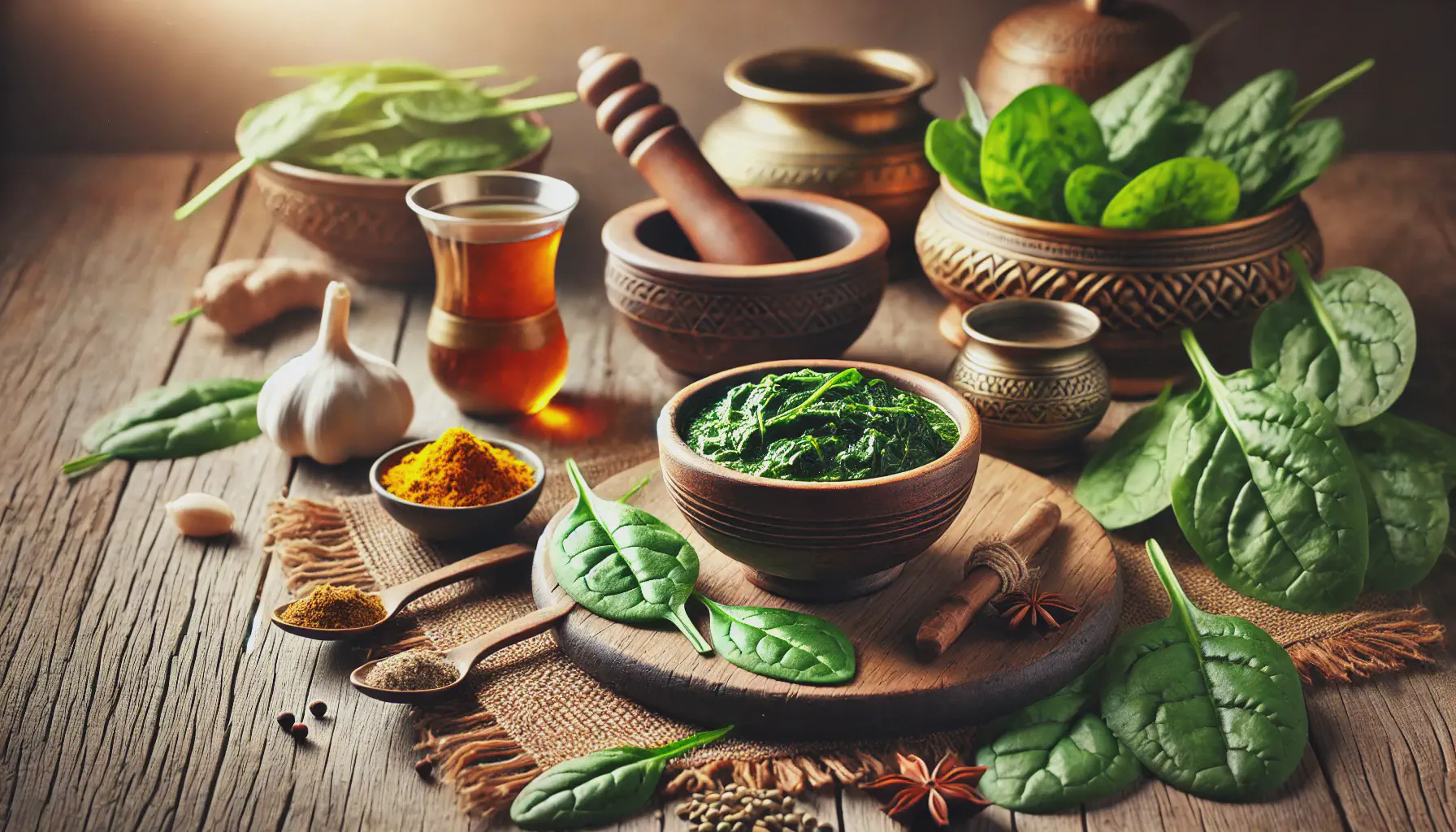
The Solar Leaf
By Jens Geffken - WrittenThe solar leaf or just Spinach, scientifically known as Spinacia oleracea, is one of the most nutrient-dense leafy greens available. Revered in both modern nutrition and ancient Ayurvedic traditions, spinach has been a staple food across cultures for centuries. Whether eaten raw in salads, blended in smoothies, or cooked into hearty dishes, spinach offers a plethora of health benefits. This article provides an in-depth look at the nutrients in spinach, its benefits, three Ayurvedic recipes without onions and garlic, and a brief history of its cultivation.
1. Nutritions of Spinach
Spinach is packed with vitamins, minerals, and antioxidants, making it an essential addition to any diet. Here is a breakdown of its key nutrients, minerals and antioxidants:
- Vitamin A – Essential for eye health and immune function
- Vitamin C – Supports collagen production and boosts immunity
- Vitamin K1 – Crucial for blood clotting and bone health
- Folate (Vitamin B9) – Important for cell division and fetal development
- Iron – Helps in oxygen transport and prevents anemia
- Calcium – Supports bone health and muscle function
- Magnesium – Aids in muscle relaxation, nerve function, and energy production
- Potassium – Regulates blood pressure and heart function
- Lutein and Zeaxanthin – Protect the eyes from harmful blue light and oxidative stress
- Quercetin – Has anti-inflammatory properties
- Nitrates – Improve blood circulation and heart health
2. Benefits of Spinach
The high concentration of vitamins, minerals, and phytonutrients in spinach contributes to several health benefits. Supports the heart health. Spinach contains heart-friendly compounds like potassium, magnesium, and nitrates, which help lower blood pressure and improve cardiovascular function. It enhances digestive health and with its high fiber content, spinach promotes healthy digestion, prevents constipation, and supports gut microbiota. Boosts Immunity. The presence of vitamin C, beta-carotene, and antioxidants helps strengthen the immune system, protecting against infections and diseases. It promotes bone health.
Vitamin K1 in spinach aids in calcium absorption, reducing the risk of osteoporosis and fractures. Supports vision and eye strength. Lutein and zeaxanthin reduce the risk of macular degeneration and cataracts, keeping eyes healthy. Regulates blood sugar levels. Spinach has a low glycemic index and contains alpha-lipoic acid, which enhances insulin sensitivity and helps regulate blood sugar levels.
3. Ayurvedic Spinach Recipes (no Onions or Garlic)
In Ayurveda, spinach is considered a sattvic food that balances Vata and Kapha doshas while mildly increasing Pitta. Below are three Ayurvedic spinach recipes that exclude onions and garlic for those following a pure sattvic diet.
1. Palak Moong Dal (Spinach and Yellow Lentil Soup)
A light, nourishing dal that aids digestion and strengthens immunity.
- ½ cup yellow moong dal (split yellow lentils)
- 2 cups fresh spinach leaves, chopped
- 1 small tomato, chopped
- ½ tsp turmeric powder
- 1 tsp cumin seeds
- ½ tsp grated ginger
- 1 tsp ghee
- 4 cups water
- Salt to taste
- Fresh coriander leaves for garnish
Cooking instructions are as follows: Rinse the moong dal and cook it with 3 cups of water and turmeric powder until soft. Heat ghee in a pan, add cumin seeds, and let them splutter.
Add grated ginger and tomatoes, sautéing until soft. Mix in the chopped spinach and cook for 2-3 minutes. Add the cooked dal and salt, then simmer for another 5 minutes. Garnish with fresh coriander leaves and serve warm.
2. Spinach and Cumin Rice
A light and flavorful rice dish that aids digestion and provides essential nutrients.
- 1 cup basmati rice
- 2 cups water
- 1 cup chopped spinach
- 1 tsp cumin seeds
- 1 tsp ghee
- ½ tsp turmeric powder
- Salt to taste
Cooking instructions are as follows: Rinse the rice and soak it for 20 minutes. Heat ghee in a pan, add cumin seeds, and let them crackle. Add spinach and sauté for 2 minutes.
Add turmeric, salt, and drained rice, mixing well. Pour in water, cover, and cook until the rice is soft. Fluff with a fork and serve warm.
3. Spinach and Coconut Curry
A creamy, mildly spiced dish that balances all three doshas.
- 2 cups chopped spinach
- 1 small carrot, diced
- ½ cup coconut milk
- ½ tsp mustard seeds
- 1 tsp grated ginger
- ½ tsp turmeric powder
- ½ tsp coriander powder
- 1 tbsp coconut oil
- Salt to taste
- Fresh curry leaves (optional)
Cooking instructions are as follows: Heat coconut oil in a pan and add mustard seeds.
Once they splutter, add ginger and turmeric powder. Stir in the chopped carrot and cook for 5 minutes. Add the spinach, coconut milk, salt, and coriander powder. Simmer for 5 minutes until well blended. Garnish with curry leaves and serve warm.
4. History of Spinach
Spinach is believed to have originated in ancient Persia (modern-day Iran and surrounding regions). It was later introduced to India and China, where it was highly valued for its medicinal and nutritional benefits. By the 9th century, spinach had made its way to the Mediterranean, where it became a staple in Arabic and European cuisine. The plant thrived in Spain, from where it spread throughout Europe and eventually to the Americas.
Today, spinach is cultivated worldwide, with China, the United States, and India being the largest producers. It flourishes in temperate regions and grows best in cool climates with well-drained soil.
Conclusion
Spinach is a powerhouse of essential nutrients and an integral part of a balanced diet. Whether consumed raw or cooked, its health benefits are vast, supporting immunity, heart health, digestion, and more. By incorporating spinach into daily meals through Ayurvedic recipes, one can enjoy its benefits while aligning with a sattvic lifestyle. With its rich history and global cultivation, spinach remains one of the most versatile and nutritious greens available today.